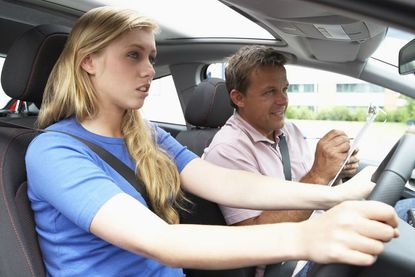

The UK’s driving test is among the most challenging in the world, with the current average pass rate standing at just 45.8%.
Figures release by the Driver and Vehicle Standards Agency (DVSA) in April revealed that Birgham had the lowest pass rate in Britain in 2018, with only 29.6% of drivers passing their test on the first attempt, the BBC reports.
Scotland, meanwhile, had some of the highest test scores in the country. Inveraray, a small town in Argyll and Bute, leads the way at 84.9%, followed by the port of Mallaig with 83.3%.
Escape your echo chamber. Get the facts behind the news, plus analysis from multiple perspectives.
SUBSCRIBE & SAVE
From our morning news briefing to a weekly Good News Newsletter, get the best of The Week delivered directly to your inbox.
From our morning news briefing to a weekly Good News Newsletter, get the best of The Week delivered directly to your inbox.
Whether you’re learning to drive in the Scottish Highlands or on the streets of Birmingham, here’s our guide to what applicants can expect when learning to drive:
How to get a provisional driving licence
Applicants can apply online and must:
Book a driving lesson
Once applicants have a provisional licence, they will be allowed to start learning how to drive. They are advised to be taught by an approved driving instructor, but can also practise with friends and relatives under certain conditions. Learners must always have “L” plates displayed prominently on both the back and front of a vehicle when driving.
How much do driving lessons cost?
There is no set cost, as prices for official driving lessons vary widely across the country and some people will require more lessons than others. As a rough estimate, comparison website uSwitch estimates says driving lessons generally cost between £20 and £30.
The DVLA does not require a minimum number of lessons, but the DVSA says the average person will need 47 hours of lessons and 22 hours of private practice before they are able to pass their test, the website reports.
What to expect from a driving theory test
The first part of the exam is comprised of a 50-question multiple choice test that covers everything from road signs to safety questions. Applicants will need to get at least 43 questions right within 57 minutes in order to pass.
The second part is a hazard perception test, where applicants must identify 15 hazards in a series of short video clips. The faster a person is able to identify the hazards, the higher they score. Applicants need to score a minimum of 44 out of 75 to pass.
Learner drivers must pass both parts of the test to proceed to the practical exam, which has to be taken within two years of passing the theory test.
What’s required in the practical exam
The practical exam is made up of three parts:
New changes to the practical test came into effect in December to try and bring the format up to date by including modern driving styles and technology. They involve satnav challenges, tweaks to the manoeuvres, longer independent driving sections and an expanded distraction test.
Applicants must ensure they bring the correct documents, otherwise the test will be cancelled.
Cost: £62 on weekdays or £75 on evenings, weekends and bank holidays
Common mistakes
You are allowed 15 minor errors before you fail a test, says The Independent. But “one big mistake, such as speeding or answering your phone, and you’re done, of course,” it adds.
Less than 50% of people pass their practical test on their first attempt, and experts say there are often many things to blame. Some of the most common mistakes include poor observation at junctions, failing to check blind spots during reverse parking, incorrect signal use, incorrect positioning on the road and driving at the wrong speed, according to the Car Expert.
Tips on passing
Carbuyer suggests that many people try to take the test too early. “A good instructor will recommend when you should book your test,” the website says, “so don't be too hasty.”
The RAC also has a list of handy tips to help you pass the first time:
Finally: try your best to stay calm. “Any time you feel tense or feel you’ve lost your focus, or if you feel you’ve made a mistake on your test, remember to concentrate on your breathing and take a few deep breaths,” says Auto Express. “This will calm your mind, stop you dwelling in the past and help you focus on the next instruction.”
Can you use your licence abroad?
At present, British driving licences are valid in all EU or European Economic Area (EEA) countries, and Switzerland.
Outside of the EU/EEA, British drivers may need an International Driving Permit (IDP) which is recognised in 140 countries around the world and acts as temporary proof of driving ability for travellers.
You can get an IDP directly from the AA, the RAC or Post Office for £5.50. To be eligible you must: by a GB or Northern Ireland resident, have passed your driving test, be 18 or over.
What about after Brexit?
While the terms of Britain’s future relationship with the EU have yet to be agreed, there is a chance British driving licences could become invalid after Brexit, with Brits wanting to drive on the continent forced to pay for a new permit.
Last year, the European Commission claimed the UK’s departure from the EU could see the end of “mutual recognition” of licences.
According to Auto Express, the Commission has said it was likely British licences would not be valid overseas from October, after EU law-based rights and benefits ceased for UK nationals.
A recent meeting of EU officials suggested UK drivers would have to purchase an International Driving Permit (IDP), which would allow them to drive in the EU for up to a year.
While the £5.50 fee “might not leave a major dent in your pocket, the inconvenience of having to be approved for another permit could be enough to deter Brits from driving to neighbouring nations”, says The Sun.
Leaving the EU is also likely to have an impact on the look of UK driving licences with MPs already suggesting the corner EU flag should be replaced by the Union Jack and other regional banners.
For rules on driving in foreign countries it is always good to check with a motoring organisation like the AA or the RAC.
What about renting a car aboard?
In 2015, the DVLA introduced an improved driving licence checking system after British holidaymakers complained of difficulties in hiring cars abroad.
In the past, car rental companies have requested to see the green paper counterpart to a driver’s licence. Now they will be able to view a driver’s details on the DVLA electronic database.
To enable a car hire company or employer to see your driving record, you will need to create a “licence check code” by logging on to viewdrivingrecord.service.gov.uk. This single-use access code is only valid for 21 days.
Used alongside the last eight characters of your driving licence number, it will allow the company to see which vehicles you can drive and any penalty points or disqualifications you have been given.
Employers who need to check an employee’s driving record will also be able to use the service.
Motorists can check their driving record by calling DVLA or visiting www.viewdrivingrecord.service.gov.uk. They will need their driving licence number (found in section five of their driving licence photocard), National Insurance number and postcode. Alternatively, drivers can apply by post to see what information the DVLA holds on their driving licence.
The green counterparts are not the same as the old-style paper driving licences, which were issued before photocards came into existence and are still used by around eight million drivers.
Can learner drivers go on motorways?
Yes, learner drivers with a provisional licence can now drive on motorways, thanks to new laws passed in last year.
However, the rules for learners are slightly different on motorways than on Britain’s other roads.
Learners can only head onto a motorway if they are accompanied by a driving instructor in a car fitted with dual controls - where the passenger seat has its own set of brake, accelerator and clutch pedals.
The decision to allow provisional licence holders onto motorways is aimed at giving them more experience and confident, the BBC says.
But the Government hasn’t changed the format of the driving exam, with no plans to add a motorway driving section in the practical test.
Driving instructors are not required to train learners to drive on motorways either. If one of their clients requests such instruction, it’s up to the instructor to determine whether they are ready for high-speed roads, says Sky News.